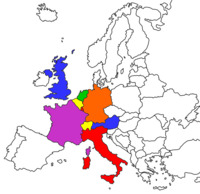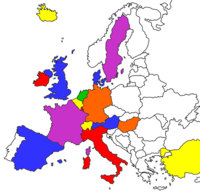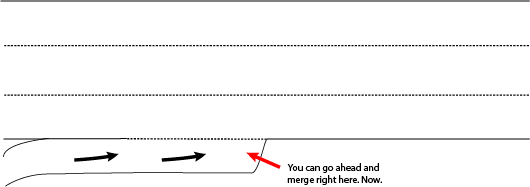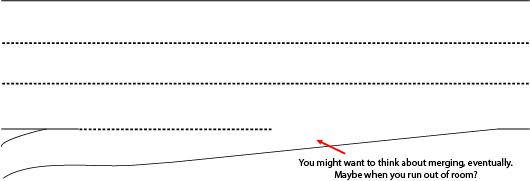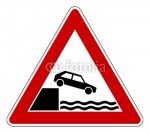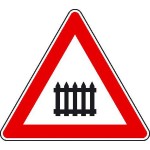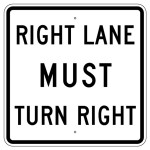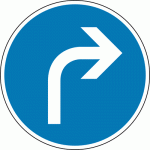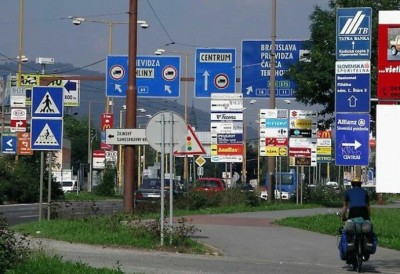Automotive
I get it, TDIgate is a big deal. We have an affected TDI. But truthfully, cars that aren’t EPA-compliant have always existed, and more than a few made it into the US with nary an issue. Here’s the story of the other EPA-non-complaint Volkswagen we have owned.
It was time to buy a second car – we’d both scored good jobs in opposite directions from the house, and one car wasn’t going to work. The old Integra was still running great. I was sure I’d wiped all of those dirty EU thoughts out of my spouse’s head, but he wanted a Golf. Ok, Golf it was. We must have test drove fifteen of them. It was the third generation Golf, not really the high point of the Golf franchise, so I was really disappointed. Soggy suspension, flat seats, plastic everywhere. And that autotragic. Yuck. Every single one of them was a disappointment. Then, one day, we drove a dark green five-door. It was different.
Side note: There was a Nugget Yellow G60 on the lot, too. I was actually in love, but was pretty confident that it would mean the end of my marriage. I didn’t even know anything about G60s back then. Ah, I still dream about that thing….. Black leather interior…. 5MT…. But I digress.
The green five-door was stiffer. It was quicker off the line. The autotragic was less tragic and almost magic. It was super close ratio, very odd in the US. Everything about the car was far closer to what I expected from Volkswagen than any of the other Golfs we drove. Ok, I’ll accept it. But I hemmed and hawed about that yellow G60…. And signed on the Golf.
It was easy to speak well of the car. It delivered like my ’88 Integra did. Everything worked, and what didn’t was repaired or replaced by the dealer. All was well.
About a year into ownership, we got the dreaded red envelope in the mail. The first of two, actually. It mentioned that the transmission in the car was not intended for the US market, instead it was a Swiss market transmission. For mountain climbing. Well, we lived on a small mountain in Philly, so no wonder we liked it. We didn’t have to exchange it, but if we wanted to, the dealer would put in the proper US-spec transmission and we would get better mileage. I laughed, because now I knew for sure that we had a close-ratio automatic as I suspected. It was a substantial upgrade over the normal 4sp box.
A few weeks later, we got the second red envelope, this one with a bit more forceful language in it: the engine was recalled. We were to take it back to the dealer for a new motor. The one we had might not pass US emissions testing, and VW could not guarantee the emission system would work in accordance with US laws. We would only get the full emissions system guarantee if we had the engine replaced, and they would do the entire powertrain for us to be safe. If for any reason, the emissions failed testing at a dealership, the car would have to have the entire powertrain replaced with a US-legal unit at no charge. That letter went into the same file. I learned that at that time, EPA could not force us to do a darn thing. Only safety recalls could be enforced.
The suspension that did not conform to whatever the FMVSS for suspension is was not recalled, although it probably should have been.
It took me several years to ferret out exactly what had happened with the car. It wasn’t until we started hearing the same line from the dealer during service visits: “Sorry Mrs H, but we have to air-freight parts from Germany. Your part numbers aren’t in the US system.” It finally clicked. I queried the parts counter and discovered the parts were indeed Swiss market. What else is wrong with this thing?
Back in the day before VW figured out that the Toyota Production System (TPS or Just-in-Time) really did work, they built cars at Puebla using the campaign model. This was the standard since the time of Henry Ford, so it’s hardly that bad of a model. It’s very efficient. Four hundred cars for the US market in silver with black interiors and 4-speed automatics mated to 2.sl0s. One hundred cars for the German market in Tornado Red with beige interiors and 5MTs mated to 1.8s. And so on. We caught a campaign-switch car, where a few powertrains and running gear assemblies were leftover from a Swiss campaign. This happens when a body is too damaged for use, the paint is bad, any number of problems that force the body off the line after the VIN is stamped on. They were mistakenly married to bodies with VINs designated for US delivery, which got proper US interiors during final assembly, making the problem nearly impossible to spot. This offset affected less than ten cars – I believe about four total.
When the transmission eventually failed (a VW thing), our good relationship with the dealer service and parts team paid off – they were able to source and obtain the exact same transmission. Of course, it took a week to air-freight it from Germany, but who’s counting?
We eventually traded the car in on our first TDI, which has its own interesting tales, too. We did not discuss the outstanding emissions recall.
And that’s the story of the other EPA non-compliant Volkswagen we owned.
Germany has a rule-based culture, and a fair chunk of life is spent figuring out how to get around the rules while still obeying them. Spirit vs letter of the law. In the US, we prize the Spirit of the Law. In Germany, it is the Letter of the Law. Once I figured this out, my life in Germany got to be fantastically easy. Just figure out how to get around the rule while creatively applying it, and you are fine. VW’s emissions control defeat programming would put the cars in compliance with the Letter of the Law, which specifies the testing conditions, while violating the Spirit of the Law, which says “don’t pollute”.
I am totally guilty of this, and I think the statute of limitations is up by now.
My wonderful MkIII Golf GT TDI (up top there) was not really in compliance with anything. It was low. It was leaky. Very leaky. And it sort of stopped. However, it was only a few hours of work away from passing the TÜV. Just like every other modified car in Germany – I had a procedure to get my car ready.
This is what it took:
- Porous head gasket. Several cans (ok, close to a case) of engine cleaner, a lot of rags, and two toilet brushes. Over the course of several hours, I removed enough oil and coolant residue to power a small nation. I also ran the coolant mixture down to about 10% glycol. Arrive at testing station just in time so car is hot.
- Badly worn summer tyres. Swap on winter wheels with good snows. Same thing if I was running too-large wheels, but I wasn’t.
- Lame brake pads. While I was in there swapping wheels, pull off all of the calipers and rough up pads and rotors.
- Barely clearing the 10cm bar. Leave car up on jackstands for 24 hours and drive gently to testing station. Bring certification letters for suspension with me with setup that passes circled. I had considered removing the front valance, but this risked failing the obviousness test.
When I arrived at the testing station, the car was solidly at 11cm and my coil count matched the paperwork. Braking was acceptable. I got some dirty looks for my snow tyres because it was May. I earned a comment on how clean the engine was. I noted it and realized that I should have cleaned it a week earlier to look less obvious. And the emissions check was thankfully in spec with no weirdness.
I failed on a broken reflector lens.
When I went back two weeks later, the lens was all they could check. So my clearly leaking (it was dripping) and obviously too low Golf was cleared for driving, because I passed the test as it was written.
I feel kind of funny saying this, but the “pass the test as written” is a cultural thing. With regard to #Dieselgate, I am willing to bet all of Internal Combustion knew exactly what was up and didn’t really think it was that big of a deal, because they passed the test. Oops.
I hereby claim this idea and name – The Motronic Whisperer®.
Do you have a vehicle with Bosch management? A German vehicle that wishes it had Bosch management? Something with lots of wires that is driving you crazy?
Contact me. I’m starting to get pretty good at this Motronic Whispering thing.
I was back in Germany again for the last two weeks.
The Jeep Renegade is a huge hit over there. Not only did I see a bunch of them, but all in nutty loud colors and parked to be seen. I like this vehicle a lot and I think FCA hit a home run with it. The popularity in Germany is proof.
Motorcycle parts are far more widely available, as usual. I managed to warp a rear rotor (yes, I actually warped it) due to the crappy Brembo 11mm master cylinder corroding again. In the US, the best fit rotor is the stock BMW one, for $248. EBC makes one that I haven’t seen yet for about $150. The OEM TRW rotor is a whopping 68€ from Louis. Yes, I brought home a brake rotor. The CBP guy who stamped my passport back in looked at his deskmate and said “I clearly need to go over there and buy some parts.” Yes, you do, Mr CBP Officer. A set of matching TRW pads cost a whole 37€. With the exchange rate at stupid lows, that was a no-brainer. I haven’t really addressed the spares situation in the past, but thanks again to Motorrad Alexander who delivered an annoying piece of wiring harness to my desk for 20% of the cost new. It’s in great condition and should resolve some nagging issues I have with harness damage on the BMW. I’ll be repairing the old one and saving it for the other frame.
Eggs. When you go to the breakfast buffet in Germany, the scrambled eggs are real eggs. I forgot how awesome this is until we went to San Antonio for a long weekend a few weeks ago and had the American version made from powdered eggs. Not even close.
I always forget how much I miss riding the trams and walking everywhere. It’s sooooo nice. A totally different kind of mobility.
I do have a gripe with airline food. I have Celiac disease, which can suck for a variety of reasons. One of them is airplane food. I finally figured out what is going on with the grilled chicken breast, broccoli, and rice that I get on every. single. flight. It’s not only gluten-free, it’s Kosher, Halal, lactose-free, low sodium, and whatever else you can come up with short of vegetarian/vegan. It’s also generally flavor-free and boring. Everyone else gets something different each flight, I get that damn grilled chicken. I have to beg for butter, explaining that I am not lactose intolerant or anything else. I do love the rolls that I get on the flight home, they are way the hell better than the rice cakes I get on the flight out. One positive note is that Delta flight attendants, pursers, and stewards are generally quite food allergy aware. This time, I was able to get scam an ice cream and it arrived with no cookie! I know that the airlines are kind of dependent on LSG or whoever their food service contractor is, so I don’t want to come off as bagging on Delta. But I would like some fancy food once in a while!
I was counting cars in the parking lot for a project and discovered that Germans like big window glass just as much as Americans do. I wonder if the area of the greenhouse is why people here like SUVs so much? With sedans losing glass at every increasing rates, it seems that eventually the only way to get a real rear window will be in a minivan or other xUV. Hmmm. Now I want to call hatchbacks UUVs – urban utility vehicles. I guess minivans would then be FUVs – family utility vehicles. Let’s tacticool name all the vehicles!
I was completely shopped out from my last trip, but not enough so to avoid looking in the windows at Hein Gericke. Oh, damn, another pair of gloves – from Richa and size Ladies’ XL. What a concept – I have a difficult time finding gloves with long enough fingers, hopefully these will do it. Thankfully, LS2 seems to be doing a great job of bringing HG back into form. The new assortment is quite attractive and continues the tradition of high-end product lines.
I (finally) learned how to pronounce Garching. I used to say /gar’ shing/. Now I say /gar’ hing/. With that silly-sounding Bavarian hissing H.
It’s taken me a while to get my head wrapped around this, but finally, here it is: why the US fails at zipper merges. Surprise, it’s not entirely the fault of our poorly-trained drivers.
I noticed this when I was living in Germany – the zipper merge (all traffic uses both lanes prior to the merge point and lanes take turns merging) is smooth and seamless (ha ha) over there. It just works. In the US, you find two behaviours – either the drivers merge into one lane long before the merge point and drivers are incensed at those who use the free lane, or the drivers use both lanes, but do not take turns. Both behaviours are wrong and at best slow traffic, at worst lead to road rage and/or accidents.
However, I’m not in a hurry to blame America’s drivers for this one. Instead, I’m going to blame our traffic engineers. Let’s have a look at the typical road markings for merge lanes in both the EU and the US. Lane 1 is at the top, and the merging lane is at the bottom.
In the EU, well, Germany at least, the merging lane is full-width until the merge point, at which it very abruptly ends. The drivers are reminded to think about merging by a few arrows painted in the lane. The lane reduction zone is usually around 5m long, so not much time to think about it – you just take turns and move on with life. The dotted line between the merging lane and the through lane is usually about five to ten car-lengths long.
In the US, the merge lane gradually narrows over (usually about) a quarter mile, gently nudging cars over. The dotted line often disappears when the merging lane is less than half of a normal lane width, further complicating the marking. This can create additional confusion about when particular vehicles should actually complete the merge.
The difference between the two is that the EU markings clearly indicate that the lane is ending at a fixed point, while the US markings allow the lane to continue to exist for various lengths depending on vehicle width. This confuses the issue of when exactly to merge, because let’s face it, if you are smart, you don’t merge until you have to. The confusing lane markings mean SUVs have to merge before motorcycles do, and most drivers will posit that that is hardly fair! On the other hand, if you’re one of those early mergers, you don’t even realize that you could use the whole lane, because it disappears in such a tricky manner and you want to avoid that ambiguity at all costs. Which you do by merging early and blocking up traffic for everyone. The worst cases are those drivers who are sadly so confused that they opt to drive in both lanes (halfsies!) and block both of them to forward progress.
Although I’ve drawn the roads as entrance ramps, this exact setup works (in both cases) the same for regular lane reductions due to construction, road use, etc.
The Federal DOT could do us all a favor and modify their guidelines for merge lane markings. The clearer EU setup not only promotes the zipper merge through logical markings, but also subtly discourages lane straddling. Coupled with a bit of driver education, this change could zip up one of the most annoying road issues we have to face today.
This is a theory of mine: the problem with drivers in the US is our road signs: they have too many words on them, and our population’s declining literacy levels are making this a challenge for compliance with the posted placards.
I lived in Germany for a while, where the Vienna Convention on Road Signs and Signals holds. Vienna describes a group of symbolic signs nearly devoid of text that control the safety aspects of roadway behaviour in the EU and other areas of the world agreeing to the convention. Notable in not agreeing is, of course, the US. I found that after a period of adjustment, the signs were easy to interpret and that I could respond almost instantly to them, because visualization was all that was required. I did not have to process them. Well, “no parking” and “no stopping” took a while to sort out, but hey, who is perfect? By the way, do not drive your Volkswagen Cabriolet off of the dock and into the river. You will likely get wet.
A typical Vienna convention sign has a ground color, an accent color, a shape, and a symbol. For example, the speed limit sign is circular (command) with a white ground (information) with a red outer ring (prohibition) and a number in the middle (actual speed limit). A parking area sign is square (informational) with a blue ground (permission or recommendation) and a white P (parking area designation). All of the signs follow a few rules and language independent. Two faves are these, which are actually related.
For example, consider the signage on the south side of the intersection of Coolidge Highway and Big Beaver Road in Troy, MI. The right lane must turn right, and is signed as such. Compare this to the Vienna sign, which is a simple blue circle with a white directional turning arrow.
A few of our colleagues have gotten the point, and signs like this one are starting to show up. The arrows require little to no processing to understand, and the only is completely superfluous, likely a throwback to the wordy original.
I could go on at length with comparisons, but I think you already get the picture (pun wholly intended).
So, why am I bothering about this? My older son is taking his introductory driving course here in MI this month. He’s learning about road signs and such, and he’s noticed the peculiarities of our wordy signage already. One is something the Germans call the “Schilderwald”, or forest of signs. It happens when a large number of signs are erected close together. Examples in the EU are numerous, and typically hilarious as the signs often conflict with each other. It is not unusual to find people taking photos, a non-trivial number of which will be used to contest traffic citations.
In the US, we persist in using signs with words on them. In English. Imagine a Schilderwald using our signs, and how long it would take to read all of them. The pictograms are enough work! Thankfully, this mess is only for pedestrians, who have time to stop and process it.
So, let me get up on my soapbox here and argue for conversion to the Vienna Convention. It would make life easier, better, and much more fabulous, being that everyone would have a shot at driving sanely, regardless of their literacy level. Imagine a US where everyone can interpret the signs and follow directions. Where even the most distracted texting driver has to only look up from their phablet for half a second to catch the sign, know what it means, and do what it shows. Where reading of road sign text will never more distract anyone from the road, or whatever the heck it is that they are doing on it. Paradise is what it would be.
At the same time, maybe we could finally convert to metric, too? Please? They already have the signs for that made up.
About the two signs at the top, which I playfully call the caterpillar sign and the picket fence sign. The caterpillar sign indicates an ungated railroad crossing. And, you guessed it, the picket fence indicates a gated one.
I wrote this maybe ten years ago, and it still stands. I’ll be deploying this in a few short weeks when my 15YO gets through with the state mandated minimum driving school. In the world of motorcycling, we call this process “learning to operate the controls”. It is very much different than riding, because riding assumes that you can operate the controls (relatively) instinctively. Driving is the same way – you need to learn to operate the controls first. Interestingly, as I read back over what I wrote, I realize that this is also exactly how I learned to operate the controls when learning to ride. I guess I knew something useful even back then!
From the VWVortex – the original thread has long since disappeared into the bit bin, but I did manage to find a quote of the text. I figured it might be helpful to someone, so here you go.
How to Teach Your Fianceé to Drive Stick Shift
Take her to a parking lot with not too many light poles and at least one speed bump. This is a 30 minute drill.
Have her start the car and then let off the clutch until the car rolls. Do this about 10 times – clutch in, clutch out to roll. This will teach her the friction point.
Next, have her add gas at the friction point. This will teach how to launch without driving into the neighbor’s yard. She should accelerate to 10mph each time. Clutch out, add gas, 10mph, stop.
That night: teach her the pattern. Have her practice it while she’s watching TV or whatever. 1-2-3-4-5-6-R. Over and over until she wants to kill you. For added misery, add the clutch drill – Clutch in. Clutch out, gas on. Brake on, then clutch in. Brake off. Cycle back to clutch out, gas in and repeat over and over.
Next day: Speed bumps. 30-45min.
Do the friction point and 10MPH drills for a bit. Then have her roll up to a speed bump. Stop. Do the gas drill with trying to stop at the top of the speed bump. This is the creep up a hill drill. This is the hardest drill.
After 20 minutes of that or if she starts crying, do a bunch of non-running pattern work. Engine off. Clutch in, shift, clutch out.
When she grasps that, do some 1-2-3 shifting around the parking lot.
That night: more phantom pattern/foot work.
Next day: Hills. 30 minutes max. She will be tired after this. Do all drills for 15 imnutes of driving total. Then go find a hill with a moderate grade and ZERO traffic.
Forward launches up hill: First let her roll back several times to get used to the sensation. Then start with the launch mechanics.
Backward launches up hill: Same thing.
That night: more phantom pattern reinforcement.
Next day: Parking lot drills, hill drills, 20 min max, now it’s time for traffic. Use your best soothing voice.
3 hours of seat time and she will be safe to drive it.
The idea behind the phantom drills is to build muscle memory. This means your feet and hands know where to go without you thinking about it. You can do this out of the car, and should do it all the time until you are comfortable with the techniques. Yeah, it looks stupid while you’re doing it, but when you don’t have to think in traffic, you will be thankful for it!
I previously wrote about moving over from my factory lowered BMW F650GS to a standard CBR250R, and how it inspired me to re-evaluate my dependence on getting my feet down at stops.
Recently, I rented a stock NC700X for a long weekend in Germany, and it seemed so natural to ride with my feet kind of, sort of down, but not like on the F, which, honestly, I tower over. A good inch or so between me and the seat when standing. Pushing the NC up and over with my left leg and finding the ground with my right foot eventually seemed like what you do. In fact, when I hopped on the F after coming home and my right foot hit the ground while the bike was still on the sidestand, the light bulb really started to glow. When my foot dragged on the ground as I was coming to a stop, there was no longer any question. My bike is too damn low.
What I’m finally figuring out is that it is actually harder to balance a bike at a stop when your knees are bent. The knee bend introduces a degree of variance, some instability, basically extra flexion, into the system. The NC was delightful at stops, partly because the center of gravity is ridiculously low, but also because my legs are straight, and that extra flexion is not there. There is a natural stiffness. I did have to plan some stops, looking to make sure I did not ride up on top of a ridge, rather instead down in the groove so that my full foot would be placed solidly on the the ridge, but even that lost its appeal after a while. I finally came to peace with the idea that taller is actually better for an experienced rider.
I place the experienced rider caveat there, because as a novice, I needed the mental and emotional security of both feet solidly planted on the ground. This is not a bad thing in and of itself – there is no shame in wanting to be comfortable as you grow into riding. The important thing for me is that I have been able to grow out of it as I’ve added experience.
I’ve begun the process of assembling the parts necessary to convert my F from low to normal. I may never make it to Dakar heights, but getting to normal is a big and welcome step. As I master normal, I will open the door to a new world of bike choices. This is cool.

